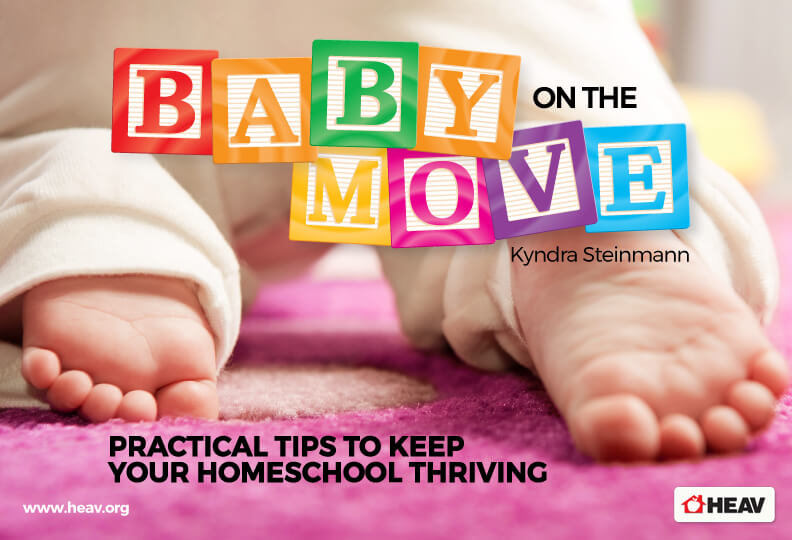Baby on the Move: Homeschooling with a Toddler
by Kyndra Steinmann
In many ways, this homeschooling with a toddler is best described as “constantly re-inventing the wheel”! We know that “the wheel”—education—is what we need, but the way we get it done is constantly changing, due in part to changing conditions and circumstances.
Homeschooling with a Toddler
Right now we are in a season of homeschooling with a very loud and busy eight-month-old. She yells in the middle of math lessons, eats every crayon she can get her hands on, and LOVES to pull up on the edges of the desks to grab at books and papers!
Some of the children find her more distracting than others, but even the most dedicated student has trouble on days when the baby is cranky for some reason. (This week, it’s her getting two teeth and having a cold at the same time that has her particularly bothered—and therefore particularly bothersome!)
So back I go, into planning mode, to figure out how to adjust things in order to keep school moving and the baby happy and contented. Here are some of the best ideas I’ve implemented:
- Start school with some children before others. This year I have an emerging reader, so his lessons take precedence over having the other children start school “on time.” I’ve tweaked the schedule to allow him to come into the school room at 7:30 and do reading and phonics with me, while the big children do their kitchen and laundry chores and the preschooler and eight-month-old play downstairs under the big kids’ supervision.
- Have special toys just for school time. We use cubby units for classroom storage, and one of them has puzzles and toys that are age-appropriate for a newly mobile child. All the toys need to be quiet, but there is a lot that can be done with small stuffed animals and soft plastic things that won’t make a loud noise if banged together. The baby’s current favorite occupations are taking all the puzzles apart (which the preschooler then puts back together—good practice for him!) and chewing on the large wooden stringing beads.
- Incorporate some Montessori-style baskets for infants and toddlers. There are some great resources out there for “play” that coincide with developmental stages. I’ve pinned a bunch of things to my ”Tot School” board on Pinterest, and I intend to start presenting my little one with simple “lessons” like taking things out of containers and putting them back in. She’s the right age to find that fascinating anyway, and I’m sure the preschooler will be happy to “teach” her!
- “Babywear.” I only started babywearing when the three-year-old was an infant, but it has been such a lifesaver. I like a carrier that goes on my back, where the baby can see everything but can’t reach anything. About half the time she falls asleep while I teach, and that short nap makes lunch time go much more smoothly!
- Have another sibling babysit. I remember this practice working for my mom, but so far it’s not been a good choice for us. The children are close in age, so only the older two are really able to watch her in another room. Both of them don’t do very well with stopping school before they are finished with their work—or, rather, getting back to it if they do—so I prefer to have them work while I manage the baby.
- Have the baby practice sitting still. She’s at the point where church is also becoming difficult, so I’m starting some “sitting still” practice with her. I hold her on my lap and say, “Sit still,” then watch the clock. Little squirms are fine, but when she starts trying to get off of my lap, I repeat, “Sit still” and then start the time over. At this point, I’m trying for two or three minutes of relative stillness with no shrieking (to which I respond, “Too loud!”). When we’ve achieved success over those two or three minutes, I say, “Good girl! You sat still!” and let her down. It’s a slow process, but eventually—by summer if I’m very consistent—she will understand what “sit still” means and be able to sit still for five minutes or more.
- Have children take an assignment to another room and return when it is complete. Both of the big kids have desks in their rooms, so they do some of their work in there and come into the school room for math and other lessons that I need to teach them. The little boys don’t find the baby as distracting, and their lessons are shorter and somewhat more interruptible, so they remain with me in the school room.
- Everyone gets a chance to learn patience! On the days when the baby is cranky and refuses to nap during school, everyone just has to learn to take their turns with my attention. It’s not a bad lesson for them—or me!—and somehow the work always does get done eventually.
I always try to remember that soon the baby will be a toddler who talks and wants to do school herself, and then I’ll have to redesign our day all over again. This time with a little one is fleeting—and will soon be past— and I want to enjoy it as much as I can before it’s gone!
What do you do with your mobile babies to make school work better for all of you?
Kyndra Steinmann blogs at Sticks, Stones and Chicken Bones about living in a houseful of young children, special needs, discipling hearts, and abundant grace! As a homeschool graduate, she has an especial burden to encourage mothers to know and enjoy their children. Follow her on Facebook and Pinterest.
Like this? Read more articles on toddlers and preschoolers here.









